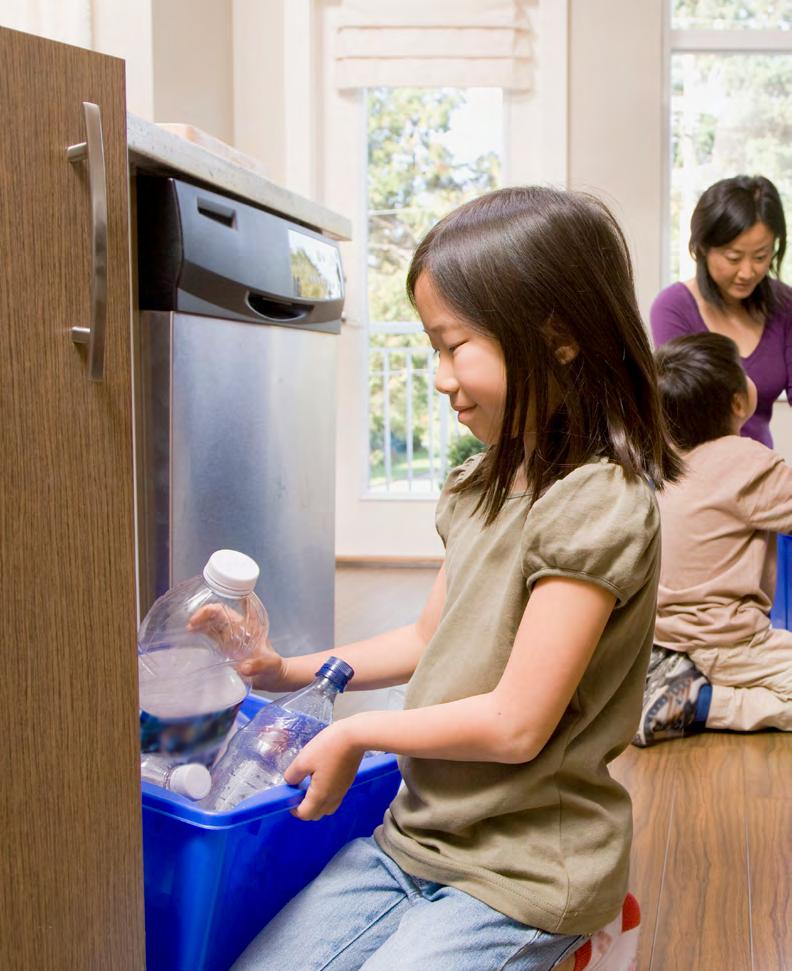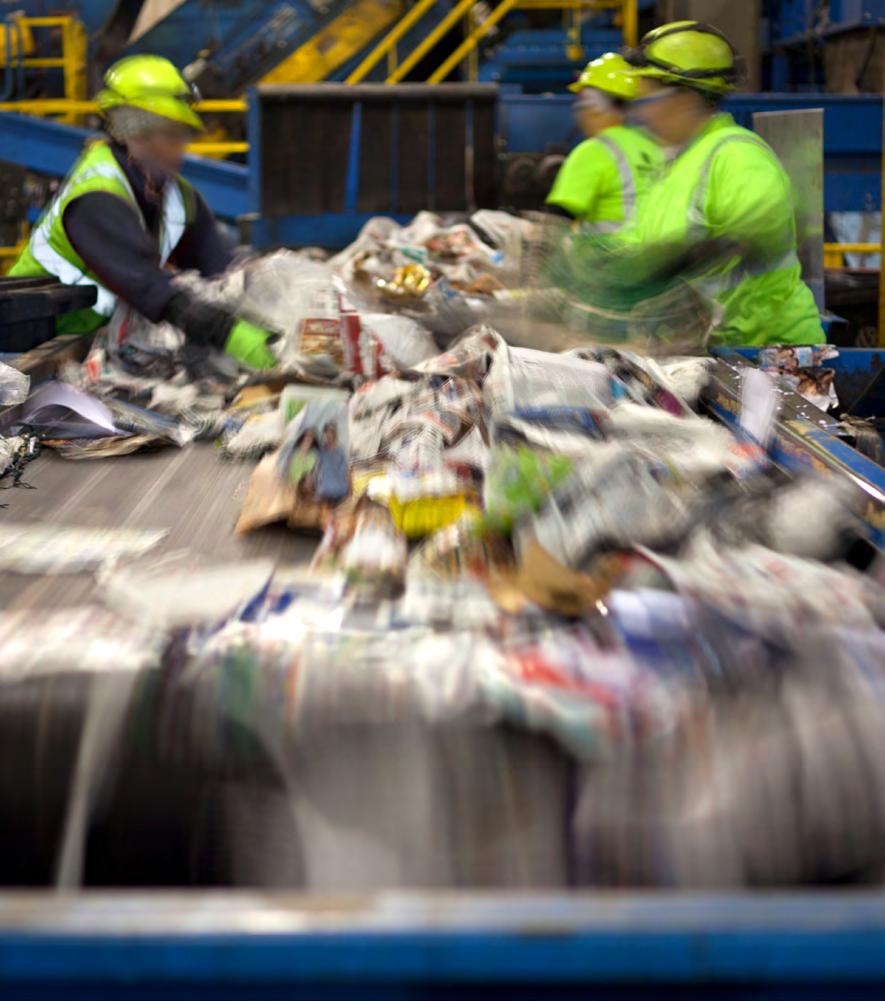
11 minute read
Executive Summary
Recycling is unique. It starts in the home but feeds a complex reverse supply chain that determines the fate of corporate recycled content and sustainability goals.
It only works if everyone can participate and the materials collected can be processed, but recycling is not provided evenly across the U.S., and many packages currently found on store shelves cannot be recycled through residential programs. The plateaued and abysmal national recycling rate makes clear that scaled and systemic intervention is needed.
Advertisement
We have the proven solutions to level up the U.S. recycling system, and it is imperative that we do so to meet the demands of both people and the planet, to create sustainable, low-carbon supply chains, and to realize the promises of a circular economy.
40% of Americans Lack Equitable Recycling
It is easy to assume that everyone can recycle as easily as they can throw something away. However, approximately 40 million U.S. households still do not have recycling access that is equitable to their trash service.
At its most basic level, equitable and informed recycling access means all people living in the U.S. can recycle just as easily as they can throw something away and understand how and when to do so. The recycling system needs dramatic investment to finally, equitably, serve all people and be inclusive of the paper and packaging found in the home.1
What will it cost to make recycling a reality for everyone?
A $17 billion investment over five years will transform the U.S. residential recycling system and make it as accessible and as ubiquitous to everyone as trash disposal.
1 Over the past decades, many packaging sectors have invested millions, if not billions, in building a better recycling system and that investment is to be commended. This report recognizes the value of the existing capital deployed in the system while also calling for a scaled and systematic investment to address its shortcomings.
Improving Our Recycling System Will Pay Dividends in the Future
$17 billion applied to proven recycling solutions will have immediate positive impact, including an economic benefit of $30.8 billion over 10 years (including wages, taxes, landfill savings, and the value of recyclables)2
$17B investment is needed over 5 years
One-Time Investment
Equitable recycling for every U.S. household New or upgraded materials recovery facilities to support domestic manufacturing Residential recycling solutions for film and flexible plastics
Annual Investments
Education and outreach strategies to improve recycling behavior
$4B $3B $4B $1.2B
Return on Investment Over 10 Years
Improved recycling system delivers + $30.8B169M tons economic benefit of new recyclables
112%
increase in recycling rate from 32-68%
$11B
in wages
$9.4B
landfill savings
710M
metric tons of CO2 equivalent avoided
$8.4B
value of recyclables
198,000
jobs created
2 Wages and taxes were calculated from here: 2020 EPA Recycling Economic Information Report www.epa.gov/sites/production/files/2020-11/documents/rei_report_508_compliant.pdf
Key Finding #1:
The US Needs an Overall Investment of $17 Billion Over 5 Years
It is a big task, but it comes with good news: the opportunity to build a better recycling system
has never been more timely or needed. There is a readiness for change among the diverse set of public and private entities – from the 9,000 local governments that run recycling programs to consumer goods companies and the private-sector collectors and processors of recyclables.
What are the signs that the time is now?
1. The public demands it. 84% of consumers expect packages to be recyclable and made from recycled material and 71% will go out of their way to support sustainable companies.3
2. Corporate engagement has never been higher. Companies are making aggressive commitments to use more recycled content, reduce waste, achieve higher recycling rates, and curb greenhouse gases.4 We see a movement not just through individual company and industry association pledges, but importantly through collaborative efforts such as the 70+ companies that fund The Recycling Partnership and the recently launched U.S. Plastics Pact. These companies realize that significant change is required
BY THE NUMBERS — OVERVIEW
$17B
over the next 5 years
0.5%
of CPG's annual sales over 5 years
50%
reduction in GHG emissions by 2030 goal set by U.S. government
84
of consumers expect recyclable packaging
0.5%
71
of consumers want to support sustainable companies
50
recycling rate by 2030 National Recycling Goal
3 SWNS survey results demonstrate that Americans prefer sustainable companies. 4 In addition to corporate goal-setting, companies are also signing onto commitments like the U.S. Plastics Pact and The Climate Pledge.
to meet their commitments – they need increased and steady material supply, and they do not want their packaging to end up in landfills or as litter.
3. Federal and state policymakers from both parties are energized. In addition to a growing number of bills concerning recycling and circularity at the state and federal levels, there is also increased support in Congress for the U.S. Environmental Protection
Agency (EPA) to take bold action, with the expectation that the U.S. will reach its
National Recycling Goal of 50% by 2030.
4. The U.S. is taking a leadership role on climate. The U.S. has pledged to cut greenhouse gas emissions by 50% by 2030. This aggressive goal will require innovative solutions and a shift to a circular economy.
What’s not included in this analysis?
This report focuses on the residential recycling system and both traditionally accepted paper and packaging, as well as those packaging formats not commonly collected in residential programs, like film and flexible plastics. It does not include an analysis of capital needs to improve recycling for commercial (retail, restaurants, offices, etc.), institutional (schools, universities, hospitals, etc.), and public spaces (parks, sports fields, pedestrian areas, etc.) – these sources of discarded material also need attention and investment to optimize material sustainability. Composting, material reduction, and reuse are also critical parts of the circular economy – an economy in which waste and pollution are designed out – but they also fall outside the scope of this analysis.
Finally, this report does not include funding for recycling operations. However, without operational support, which is the largest cost center to local governments for recycling service, uptake of recycling capital improvements envisioned by this model could be uneven and not fully optimized for maximum participation or efficiency. Packaging and products have changed significantly, and municipal service areas have expanded since recycling programs were implemented in the 1990s, but local governments still solely bear the estimated $10 billion annual cost of operational expenses to keep the U.S. residential recycling system in motion. Communities face continual and significant budgetary pressures, only exacerbated by COVID-19. Without sustainable funding for operations, communities cannot be compelled to offer recycling service, even if the cost of capital equipment is covered.5
5 More on the operation of recycling and how those costs are currently carried by local governments can be found in The Recycling Partnership’s 2020 State of Curbside Recycling Report and The Bridge to Circularity reports.
Key Finding #2:
Fully capitalized recycling infrastructure and education could double the national residential recycling rate, delivering a better, cleaner supply of all recycled materials to the U.S. economy.
The U.S. recycling system has been stuck for decades at a dismal residential recycling rate that hovers in the mid-30% range. We can increase the recovery of recyclables up to 70% with the investments outlined in this report, consistently delivering an annual supply of 32 million cleaner tons to manufacturers across the U.S. But to jump-start the U.S. recycling system, we must provide three things:
1. Recycling containers for every household that are on par with their trash disposal, making it as easy to recycle as it is to throw something away.
2. Education, outreach, and behavior change strategies to reduce public confusion of what and how to recycle, substantially improve consumer use of the recycling system, and restore trust in the recycling system.
3. Modernized and upgraded materials recovery facilities6 (MRF) sortation to accommodate all packaging materials currently found in the home, including those not typically collected in residential programs, like film and flexible plastics.7
BY THE NUMBERS — EFFECTS OF INFRASTRUCTURE AND EDUCATION
Tons of Recyclables Currently Collected Annually
Tons of Recyclables Collected Annually With Infrastructure Investments but No Education
Tons of Recyclables Collected Annually With Infrastructure Investments and Education and Outreach
6 Materials recovery facilities (MRFs) employ various manual and machine processes to sort recyclable materials, remove contamination, and process, usually by baling, for shipment and sale to various markets. 7 Materials traditionally collected in curbside programs include glass bottles and jars, plastic bottles and containers, steel and aluminum cans, cardboard and paperboard boxes, printed paper, and cartons. Common packaging formats not typically collected in the current residential system include film and flexible plastics, tubes, and plastic clamshells.
Key Finding #3:
Policy solutions need to be built with collaborative corporate, government, NGO, and policymaker engagement.
The foundations of the modern U.S. recycling system were built on sensible policies. A new wave of policy action can take the system to the next level. A shared responsibility model is needed to drive significant new investment in recycling; otherwise, we cannot address the system challenges presented in this report. It is simply too slow and expensive for any one company, community, or organization to solve.
Policymakers are looking to nonprofit and private-sector partners to inform and build pragmatic and uniquely American solutions to recycling’s challenges. The industry-led Circular Economy Accelerator (CEA) understands that if we want to level up and unify the U.S. recycling system, then we must get serious about the need for federal policy and the important role packaging companies can play in crafting a plan that works for all. In late 2020 the CEA released a policy report, Accelerating Recycling: Policy to Unlock Supply for the Circular Economy Report (Policy Report). The policy report is a testament to the need to act and the power of public-private solution-building.8
The system needs outlined in this report are quantifiable and achievable, but they will require collaboration from all parts of industry, all levels of government, policymakers, investors, and the public to bring them to fruition and maximize their potential. It is a challenge we know all
stakeholders are ready and eager to achieve. While outside the scope of this report, we recognize that the success of improved recycling access and processing is also contingent on companies designing packaging for circularity.
Circular packaging design will improve the recovery of materials as they move through the recycling system and increase the use of recycled content to stimulate market demand.
Additionally, investments are needed to grow adequate end-market capacity, which is an important consideration for policymakers and businesses alike. End markets may also need policy and financial support to accelerate expansion, but it will pay dividends as domestic end markets provide market pull for the increased supply of recyclable materials, while concurrently supporting growth in U.S.-based processing and manufacturing jobs.
8 The CEA’s members collectively helped draft the policy report, published in late 2020, which was ultimately endorsed by 18 of the world’s largest companies and trade organizations. Learn more at: recyclingpartnership.org/acceleratorpolicy/.
Return on Investment
Solving today’s recycling system challenges will double the return on investment within 10 years and deliver almost 200,000 new jobs.
We estimate these improvements will cost $11 billion for infrastructure and $6 billion for education investments over five years, and $1.2 billion annually thereafter for continued resident education.
These improvements will have an immediate positive impact, including an economic benefit of $30.8 billion over 10 years (including wages, taxes, landfill savings, and the value of recyclables).



Environment Jobs Economy
There are important returns on investment in the first 10 years alone:
1. We create almost 200,000 jobs and deliver $30 billion in economic impact. 9
2. The recycling rate goes from approximately 32% to 68%, delivering 169 million tons of new recyclables. 3. 40 million underserved households are able to recycle the packaging they receive in their homes.
4. We achieve high levels of MRF efficiency and bale quality through upgrades to 375 MRFs and the construction of 57 new MRFs, streamlining material flow from collection to market.
5. We solve tough recycling challenges like packaging that is not yet recyclable at scale. 6. We avoid an estimated $9.4 billion in landfill costs.10
7. We create an estimated $8.4 billion in new, high-quality recyclable commodities. 8. We generate huge environmental benefits, saving: • 710 million metric tons of CO2 equivalent • The average water usage of 30 million people • The average energy usage of 28 million people • The equivalent of 129 million cars’ emissions 9. We create the confidence in material supply to spur investments in new end markets and technologies. 10. We build consumer confidence in recycling and in the brands that create the products and packaging that people want and need.
Conclusion
The headwinds are significant, and as we have seen over the past few decades of attempted interventions, the U.S. recycling system will not fix itself.
The current strategy of partial grants and low-interest loans are effective at the community level but do not provide the pace of change needed.
The U.S. currently lags every other developed nation in its approach to managing recyclables in the home.
The good news, however, is that there are proven solutions, the scale of the challenge is known, and it is all within our collective power to fix through dramatically expanded public-private partnerships and robust policy that provides sustainable funding.
9 Calculated using the wage and tax multiplier from the 2020 EPA Recycling Economic Information Report, epa.gov/sites/ production/files/2020-11/documents/rei_report_508_compliant.pdf, and adding The Partnership’s calculated landfill savings and value of recyclables figures. 10 Environmental Research and Education Foundation, Analysis of MSW Landfill Tipping Fees: 2020 erefdn.org/product/ analysis-msw-landfill-tipping-fees-2/






